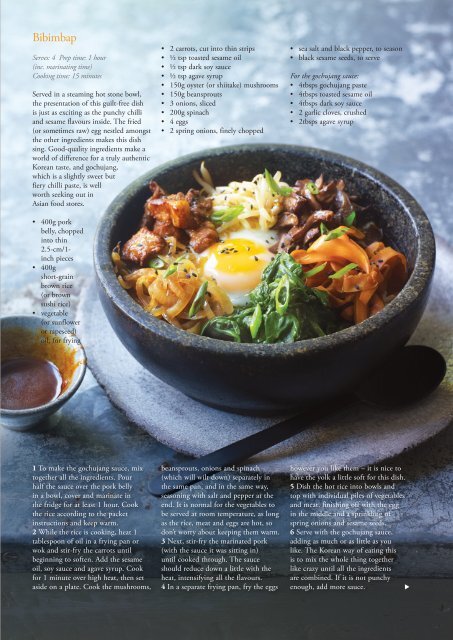Wealden Times | WT226 | March 2021 | Interiors supplement inside
Wealden Times - The lifestyle magazine for the Weald
Wealden Times - The lifestyle magazine for the Weald
Create successful ePaper yourself
Turn your PDF publications into a flip-book with our unique Google optimized e-Paper software.
Bibimbap<br />
Serves: 4 Prep time: 1 hour<br />
(inc. marinating time)<br />
Cooking time: 15 minutes<br />
Served in a steaming hot stone bowl,<br />
the presentation of this guilt-free dish<br />
is just as exciting as the punchy chilli<br />
and sesame flavours <strong>inside</strong>. The fried<br />
(or sometimes raw) egg nestled amongst<br />
the other ingredients makes this dish<br />
sing. Good-quality ingredients make a<br />
world of difference for a truly authentic<br />
Korean taste, and gochujang,<br />
which is a slightly sweet but<br />
fiery chilli paste, is well<br />
worth seeking out in<br />
Asian food stores.<br />
• 400g pork<br />
belly, chopped<br />
into thin<br />
2.5-cm/1-<br />
inch pieces<br />
• 400g<br />
short-grain<br />
brown rice<br />
(or brown<br />
sushi rice)<br />
• vegetable<br />
(or sunflower<br />
or rapeseed)<br />
oil, for frying<br />
• 2 carrots, cut into thin strips<br />
• ½ tsp toasted sesame oil<br />
• ½ tsp dark soy sauce<br />
• ½ tsp agave syrup<br />
• 150g oyster (or shiitake) mushrooms<br />
• 150g beansprouts<br />
• 3 onions, sliced<br />
• 200g spinach<br />
• 4 eggs<br />
• 2 spring onions, finely chopped<br />
• sea salt and black pepper, to season<br />
• black sesame seeds, to serve<br />
For the gochujang sauce:<br />
• 4tbsps gochujang paste<br />
• 4tbsps toasted sesame oil<br />
• 4tbsps dark soy sauce<br />
• 2 garlic cloves, crushed<br />
• 2tbsps agave syrup<br />
1 To make the gochujang sauce, mix<br />
together all the ingredients. Pour<br />
half the sauce over the pork belly<br />
in a bowl, cover and marinate in<br />
the fridge for at least 1 hour. Cook<br />
the rice according to the packet<br />
instructions and keep warm.<br />
2 While the rice is cooking, heat 1<br />
tablespoon of oil in a frying pan or<br />
wok and stir-fry the carrots until<br />
beginning to soften. Add the sesame<br />
oil, soy sauce and agave syrup. Cook<br />
for 1 minute over high heat, then set<br />
aside on a plate. Cook the mushrooms,<br />
beansprouts, onions and spinach<br />
(which will wilt down) separately in<br />
the same pan, and in the same way,<br />
seasoning with salt and pepper at the<br />
end. It is normal for the vegetables to<br />
be served at room temperature, as long<br />
as the rice, meat and eggs are hot, so<br />
don’t worry about keeping them warm.<br />
3 Next, stir-fry the marinated pork<br />
(with the sauce it was sitting in)<br />
until cooked through. The sauce<br />
should reduce down a little with the<br />
heat, intensifying all the flavours.<br />
4 In a separate frying pan, fry the eggs<br />
however you like them – it is nice to<br />
have the yolk a little soft for this dish.<br />
5 Dish the hot rice into bowls and<br />
top with individual piles of vegetables<br />
and meat, finishing off with the egg<br />
in the middle and a sprinkling of<br />
spring onions and sesame seeds.<br />
6 Serve with the gochujang sauce,<br />
adding as much or as little as you<br />
like. The Korean way of eating this<br />
is to mix the whole thing together<br />
like crazy until all the ingredients<br />
are combined. If it is not punchy<br />
enough, add more sauce.


















